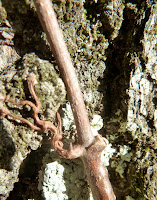 |
| Monarch Watch |
I had always assumed that they headed south to seek warmth, but this is only partially true. Heinrich explains that migration, like hibernation, is more a matter of preserving energy while food resources aren't available. They mass on the Mexican trees, hanging out for three months without eating, burning their fat much like a hibernating mammal. Their stored energy as fat must last until food is again available.
Here is where temperature comes in. They actually require cool temperatures rather than warmth. The area where most of our monarch population overwinters is above 10,000 feet where the temperature is close to but above freezing. As described by Monarch Watch, they cluster together in a very specific ecosystem, on specific tree species on steep southwest-facing slopes. In warm spells they may fly off to get a drink but otherwise they rest, conserving their precious energy.
 |
| Clustered Monarchs- Wikimedia |
Knowledge of the details of migration is relatively recent. Their lifecycle was proven by chemical analysis of their cardenolides, the toxic substance the larvae acquire from feeding on milkweed. There are differences in the "chemical fingerprint" of the cardenolides. Studies showed that the chemical found in wintering butterflies and those first heading north from Mexico was distinctive, produced only in milkweed plants from the Northern US and Canada. Their wintering grounds weren't even discovered until 1975.
Their spring migration northward is timed to the growth of milkweed food plants which their larvae require to develop. Within a short time the eggs hatch, the caterpillars go through their instars and enclose (form a chrysalis). When the adult emerges, it heads north to the next range of emerging milkweed, a procession not unlike the giant combines that follow the wheat harvest in the summer.
Come to think of it, we aren't so different as we adjust our thermostats and throw another log on the fire, seeking not warmth, but the perfect temperature to conserve our energy for the start of spring.











